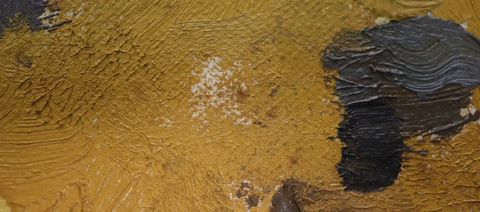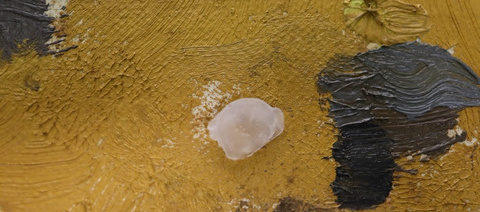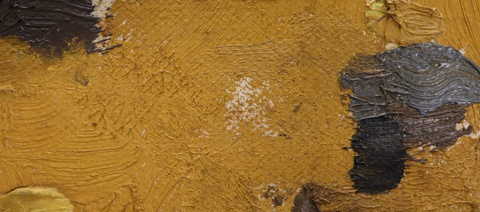Surface dirt cleaning with hydrogel in Hong Kong Government
The hydrogel project is part of the conservation placement in the Conservation Office, Hong Kong Government from June to September 2022. During the 10-week placement, various hydrogel formulas, mainly on konjac/xanthan gum gel, were tested.
Hydrogel delivers moisture slowly, which can be a possible alternative surface cleaning material for water-sensitive paintings.
What was the goal the project set out to achieve?
The painting worked on is ‘The field’, by WU Guanzhong painted in the 1990s. It is a modern oil painting without varnish. Like many modern paintings, it is water sensitive and a dirt layer is accumulated on the surface. After a dry cleaning process by previous conservators, mould spots were found across the whole painting. As aqueous solutions are not available for this painting, the conservation team decided to use hydrogel instead.
What did I do?
Several gel formulas with different concentrations have been tested:
Agar
Gelatine
Konjac/Xanthan (various ratio: 5:5, 6:4, 7:3, 8:2, 9:1)
Konjac/Xanthan with EDTA and NaCl solution
Nanorestore Gel® peggy 6
Nanorestore Gel® Peggy 6 with EDTA solution
The first four formulas of gels are made by cooking the ingredients with constant heat monitoring and stirring on a hot plate. After all the ingredients dissolves and give a clear solution, the mixture was poured onto a flat metal plate for cooling. The gel is left in room temperature for 24 hours before using it for a steadier performance.
What was the outcome?
After testing the gels in a sample, agar and gelatine gel are found to be too rigid for an impasto surface. Konjac/Xanthan gel was chosen for further testing with various concentrations and ratios.
The most elastic gel ratio of Konjac to Xanthan is 8:2, with Konjac in 2% concentration and NaCl added to help curing. EDTA 2% was added to the formula because it helped in removing mould stains.
However, when comparing the gel of the final formula of konjac/xanthan to Nanorestore Gel Peggy 6, the latter has a higher stain removal ability. Nanorestore gel was chosen for the treatment at last.
What did I learn?
Although the self-prepared hydrogel is not used in the final treatment, I learned how to adjust the formula during the preparation process:
1. Sometimes previous research papers' results may not suitable to my painting's situation. Always need to try the formula myself before the actual application.
2. Design test on the same formula with different concentrations and ratios. Compare the result in a mock-up sample to decide the best option. further test on the chosen concentration.
3. Find different reference papers for the materials. Do not only depends on one paper.
Although commercial products, like Nanorestore Gels®, are available to purchase, the supervisors suggested that being able to prepare the gel ourselves would be beneficial because the treatments would not be limited by the merchant's inventory supply and recipe changes.




